Yuko Nagai
(Secretary-General, Zoological Society of Japan;
Director, UniBio Press; doctoral candidate,
Graduate School of Library, Information and Media Studies, University of Tsukuba
)
● Introduction
In 1947, amid the shortages of paper and funds that scientific associations faced after the World War II, the Ministry of Education began to subsidize the costs of publishing periodicals. In 1965, the subsidies were incorporated into the framework of the grants-in-aid known as “Kakenhi,” and that is what is in place today. Currently known as the Kakenhi Grants-in-Aid for Publication of Scientific Research Results, they are paid mainly to researchers and scientific associations with the aim of making new scientific information broadly accessible. There are three types of subsidy under the Grants-in-Aid, covering scientific periodicals, scientific books, and databases.1 In this article, in light of SPARC Japan’s mission, I report on how scholarly communication in Japan has been affected by the continuing support for periodicals provided by the Kakenhi Grants-in-Aid for Publication of Scientific Research Results (referred to hereafter as “Kakenhi”). The two points that emerge as pivotal are the presence or absence of a business model and the move to electronic journals. In December 2011, while I was writing this article, the Scholarly Communication Working Group of the Council for Science and Technology’s Research Environment Infrastructure Group issued a report (in Japanese) titled The Effective Utilization of the Kakenhi Subsidy Program (Grants-in-Aid for Publication of Scientific Research Results) to Strengthen Japan’s Role as a Communicator of Scholarly Information.2 I would like to examine the future of Kakenhi here in light of the concrete proposals contained in the report.
● Scientific Journals and Business Models
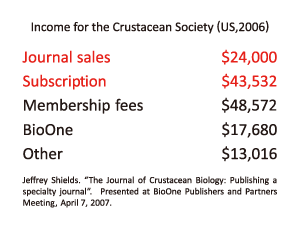
Figure 1A: Income of the Crustacean Society (US dollars, 2006)
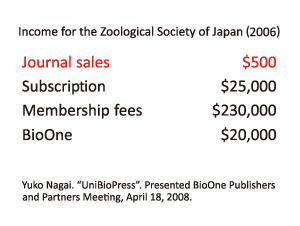
Figure 1B: Income of the Zoological Society of Japan (US dollars, 2006)
Many of Japan’s academic journals share certain characteristics, which date back in part to the founding of the scientific associations which publish them. One is the lack of a clear business model; one might also call it a lack of emphasis on library subscriptions. At the time of their founding, many associations seem to have decided that their journal(s) should be distributed to members only, since the publishing costs were to be covered by membership fees and the journals were viewed as a benefit of membership. Although the term “business model” may seem quite irrelevant to the work of a scientific association, the e-journals published by large commercial houses, on which we often rely as researchers, depend on a detailed business model, and the business model is critical to the scientific association. One of the aims of SPARC Japan has been to create a digital-based business model for all journals in Japan. SPARC Japan says of this effort: “The project was launched in 2003 through support by the Ministry of Education, Culture, Sports, Science and Technology (MEXT), and it encourages digitization of scholarly journals, especially English language journals, published in Japan,…. The aim is to create a self-sustaining cost-recovery model that will enable stable transmission of Japanese scholarly journals and improve their name recognition overseas.”3
Kakenhi subsidies have undoubtedly helped support and foster Japanese academic journals, and I want to be clear on that point. However, it is also an undeniable fact that the scientific associations have been less focused on developing a business model than they might have been if their publishing costs were not partially subsidized. Let us compare the income of the Crustacean Society in the USA (Figure 1A) with that of the Zoological Society of Japan (Figure 1B).4 The two organizations differ in scale, as the ZSJ covers a wide range of fields and thus has a larger membership. I would like to draw your attention, however, to the difference in their income from journal sales and subscriptions proportional to their size. When a society has a business model, it necessarily outgrows the idea that merely putting out a journal is enough. This leads it to constantly review its publishing activities and the journal itself in a broader context. Let me ask society publishers a question:
“If you do not currently have a business model, in what formats (digital, print, digital and print, other) do you think you could sell your journal, and at what annual subscription fee?”
If your society journal is published commercially, you should think about whether you are receiving an appropriate amount from the publisher in light of the steep rise in e-journal prices. The sharp decline in production costs of e-journals must also be taken into account. While it is true that commercial publishers’ business models prevail in the world of scholarly publishing, we should at least familiarize ourselves with the current model used by the publisher we have ties with and think carefully about how it meshes with our own goals. Selling an e-journal also means studying the choice of platforms and systems in terms of their specifications and functions, with the emphasis on what kind of system serves subscribers best.
Publishing a journal is, from the start, related to the raison d’être of the association, which must ask itself, “Can we obtain the funds for what we want to publish?” Thinking about a business model also leads it to reflect on the value of the journal itself. The question “What price can we ask?” may appear somewhat removed from the world of science, but pricing is in fact an integral part of publishing a journal sustainably; indeed, the publication will never get off the ground without a source of funds, which may or may not be subscriptions. It is possible to finance a journal solely with membership fees or other non-subscription income; that is one model. Another is to use membership fees as a source of funding and, in the 21st century version, publish an e-journal with Open Access. However, we must then consider how effective these existing models are at raising a journal’s status and name recognition, and whether this can be quantified. The business model translates directly into the publishing model. Maintaining a journal requires us not only to think about how to obtain funds, but also to constantly assess the system we are using in terms of its effectiveness in increasing the publication’s status; this is, in essence, the work that a society publisher does.
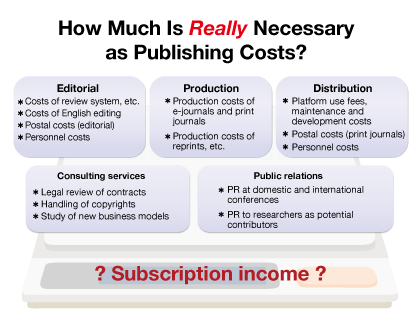
Figure 2: Example of publishing costs
As I see it, the availability of Kakenhi has meant that Japanese associations have tended not to focus on a business model for their journals. But one could also say that Japan has its own model of scholarly publishing, different from its Western counterparts and characterized by two trends that were prevalent when Japan’s scientific associations were established: the idea that journals (information) should be provided exclusively to members, and the low perception of library subscriptions as sales. This background has likely contributed to the lack of a clear business model.
To develop a business model, one must first calculate how much is needed to cover expenses. I invite readers to consider what the publishing costs for their own journals actually involve, taking Figure 2 as an example.
● Periodicals Supported by Kakenhi and the Continuing Emphasis on Print
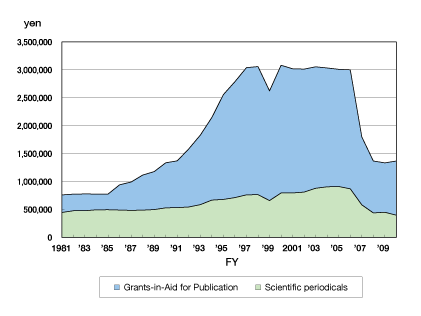
Figure 3: Trends in Grants-in-Aid for Publication of Scientific Research Results and grants for scientific periodicals
Let us return now to the Kakenhi. Figure 3 shows the total Grants-in-Aid for Publication of Scientific Research Results together with one category of these grants, those for scientific periodicals, from FY 1981 to FY 2010.
These subsidies were a cornerstone of Japan’s scientific journal publishing and undoubtedly fostered its development. But they eventually proved to be something of a millstone, as well, by restricting Japanese journals to the print format and thus delaying their digitization. Publishing houses which produced journals observed the overseas trends early on and began experimenting with automation and XML production for digital content, but the market (i.e., the scientific associations) remained committed to the typographic print format called for by the Kakenhi protocol. Also, because a journal’s quality does not improve overnight and suddenly raise the journal up to the level where it would meet the Kakenhi standards, there has been an inevitable tendency to continue making grants to the same journals for many years once they qualify. It probably became steadily harder for the grant-makers to reject a repeat applicant as they became more familiar with the journal’s standpoint and significance and as its international status rose. It should also be noted that the Kakenhi grant process is the only one in Japan to utilize the NIH system, in which the final decision is made by consultation after a preliminary screening.4 Despite the transformation that has overtaken scholarly communication in the last decade, however, MEXT and the Japan Society for the Promotion of Science (JSPS) have been unable to foster journals, and, in particular, to shift the basis of their grant-making from the publication and sale of printed journals to the production of digital journals, with an eye to keeping in step with journal publication trends worldwide. Such a shift, even if it had been attempted, would have been highly problematic, as the scientific associations rely on these grants (together with subscriptions and membership dues) to publish their journals, and the subsidized titles rank among Japan’s leading journals. A sudden about-turn in policy, such as discontinuing grants for print journals, would obviously have thrown scholarly publishing into disarray; thus, in terms of supporting scientific communication in Japan, a decisive shift toward subsidizing e-journals would have been difficult to achieve.
At this point, I would like to summarize the situation seemingly favored by Kakenhi, a situation which has become virtually unique to Japanese scientific journals.
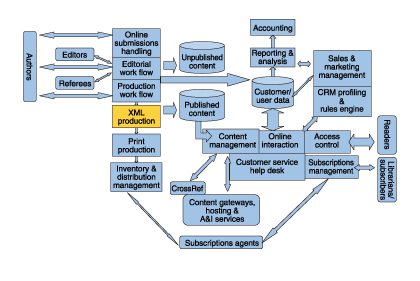
Figure 4: The journal publishing workflow in the early 21st century
Source: Mark Ware (2007). “Journal publishing systems: outsource or in-house?” Learned Publishing, vol. 20, no. 3, fig. 1.
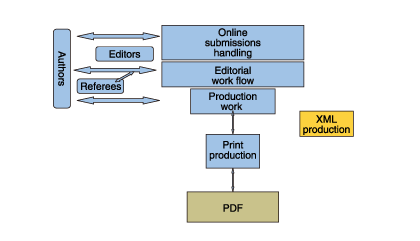
Figure 5: The electronic journal production process in Japan
○ Some scientific associations, having qualified for Kakenhi for many years, lack a strong sense of the need for a business model.
○ It cannot be assumed that a Japanese scientific association has a business model simply because it contracts out publication of its journal to an overseas commercial publisher.
○ Because Kakenhi grants are for printing costs, the move to e-journals occurred relatively late in Japan.
○ Because the market still favored print journals, even in the digital era the newly developed production flow went via print production to e-journal production (compare Figures 4 and 5).
○ Most Japanese printing companies missed opportunities to acquire the new technology required and to learn the evolving international standards for e-journal production.
○ As of December 2011, it cannot be denied that, compared to overseas publishers, Japanese printing companies on the whole lack international competitiveness in e-journal production in terms of both technology and price.
Journal publishing makes up a very substantial part of a scientific association’s activities, both financially and as a way of supporting its field. It cannot simply stop publishing from one year to the next because it is short of money. At the ZSJ, our participation in SPARC Japan has prompted, nay, compelled us to go back to the basics and think about what it means to publish a journal.
● The New Kakenhi Subsidies: Discussion and Issues
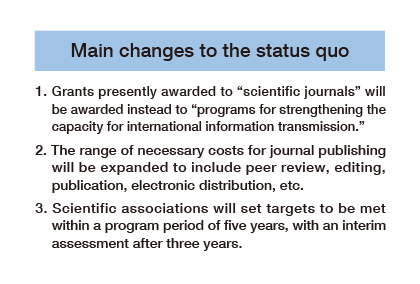
Figure 6A: Main changes to the status quo
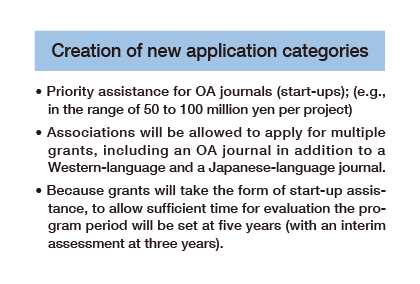
Figure 6B: Creation of new application categories
It seems to me that, if we are to produce better journals for the digital era, Japanese scientific associations have a responsibility to seriously consider the future of Kakenhi. We need to do so for the sake of our own future work, the next generation of Japanese researchers, and science in Japan. A report titled The Effective Utilization of Kakenhi Subsidy Programs (Grants-in-Aid for Publication of Scientific Research Results) to Strengthen Japan’s Role as a Communicator of Scholarly Information was issued on December 6, 2011, by the Scholarly Communication Working Group of the Council for Science and Technology’s Research Environment Infrastructure Group, and on January 26, 2012, the Working Group reported on its deliberations to the Research Resources Group. Based on this report, the JSPS is due to consider concrete improvements by about the end of March 2012. In this section, I outline the changes to the Kakenhi and the new grant categories proposed in the report and then consider the problems posed by the status quo (Figure 6A and 6B).
The current proposals seem to me unprecedented in two respects: first, they represent a major reform of the Kakenhi, which have long been dedicated to print publication costs; and second, MEXT has presented a concrete model to the Council for Science and Technology. The proposed changes include a substantial freeing-up of the modes of use of publishing expenses, and one key to future developments will be how well the associations utilize this; thus, they too will be under pressure to respond. With regard to support for OA journals, if the proposal is adopted, this will indeed be a newsworthy event at the international level. OA journals that are currently proving successful, such as PLoS and BioMed Central, received external funding initially as they faced a number of difficulties being ahead of the times. BioMed Central, in particular, has since achieved such growth that it has been acquired by Springer. But journal start-up costs are expensive, and it is especially costly to convert from a subscription model.
The recent proposals are significant in that they not only duly recognize these conditions, but also map out a course of action, namely, government support for OA journals. I anticipate far-reaching reforms that are attuned to the digital era and impact future generations. Future developments will need to be watched attentively, and it is to be hoped that the concept of the new Kakenhi framework, if adopted, can be fully realized in practice by applying the lessons learned from the problems in the existing system. I have listed these problems below, based on The Effective Utilization of the Kakenhi Subsidy Program (Grants-in-Aid for Publication of Scientific Research Results) to Strengthen Japan’s Role as a Communicator of Scholarly Information. In light of the great influence of Kakenhi on scientific associations, I would like to survey the trends among journals and discuss concrete reforms of the screening criteria and other matters, though the points I will consider remain only possibilities at this stage.
1) Quantitative Assessment Criteria in the Document Review Phase
As mentioned above, the Kakenhi have a unique screening system consisting of document review followed by a consultative decision-making process.5 Few of the present criteria are quantifiable, however, and thus it is to be hoped that the flow adopted in any future Kakenhi reform will consist of document review under quantitative assessment criteria, followed by a consultative decision. I have suggested below some potentially quantifiable criteria.
1. What is the e-journal format, and why has it been adopted?
2. Characteristics of the platform, and its advantages and disadvantages to the association under present conditions
3. Explanation of the e-journal subscription fee and e-journal business model or OA model
4. From what year is the e-journal available on the website for subscribers and for OA users?
5. Analysis of the access log (accesses from Japan and overseas, and robot accesses or “noise”), and the name of the system or method of analysis used
6. Print subscription fee, number of subscribing libraries
7. The journal’s IF, the average IF in the field, and an explanation of why the journal’s IF rose or fell in the year concerned
8. Editorial policy for the next year, based on the journal’s current state
9. Other titles with which the journal competes or which it wishes to emulate, with reasons
10. Number of submissions (by country) and rejection rate
11. Accounting system and regulations, reference year for accounting figures in the application
12. (Others) What the association is doing to improve the journal’s quality and related parameters. International projects in its field in which the association is participating. Items to be reported where the association can demonstrate that it is making an effort.
13. The expenditure of the publishing association on educational activities, and the contents thereof
Item 13 is especially important for confirming an important area of the associations’ work, namely, how much of their revenue they invest in the field, as represented by education.
2) Thorough Review of the Application Procedure, Including the Form
The application form for FY 2012 already contains some major changes, especially in regard to “Calculation of the Amount Requested.” I will not go into detail here, but will simply note that these do not stem from a change in the basic concept of Kakenhi, “making new scientific information broadly available,” but were prompted by a field audit by the national Board of Audit in FY 2010. The Kakenhi protocol, in keeping with the program’s basic concept, requires only that an association applying for a grant describe its journal and what it intends to do next to further improve the journal’s international standing. I therefore suggest the following practical changes for consideration:
○ The application should be streamlined to fit into two A4 sheets. The key point is the association’s immediate plans. If it received a grant the previous year, a report of results should be attached and the figures therein (based on the statement of accounts for the previous year) should be used to quantify the association’s performance. If it did not receive a grant the previous year, it should enter figures for its performance at the time of application.
○ Three items should be submitted as basic supporting documentation: a “questionnaire for quantitative assessment,” the above two-page application form, and the previous year’s results (a copy of a report or similar document).
○ The report of results should carry particular weight. Copies of receipts in support of the figures should be submitted with the report.
3) The Question of Peer Review
Applications for the grants-in-aid, like those for other research funds, are screened by peer review, and this is not likely to change even if the Kakenhi concept changes. However, if the proposed new concept is introduced, reviewers will have to assess “programs for strengthening the capacity for international information transmission” and “creation of an OA model.” This is a different matter from evaluating the research of one’s peers. Will scientists be in a position to do this? Also, in the event of the proposed reforms, “appropriateness of the expenditures” is likely to become the pivotal consideration, but I believe it would be a departure from the true sense of peer review if researchers were to determine this. If I may venture to suggest an alternative, why not create a review structure with a comprehensive perspective by including reviewers other than researchers, such as library and commercial publishing staff, and have them assign quantitative scores prior to the consultative decision? Applications that scored above the cutoff point (which could vary from year to year) would then be submitted to the consultative decision phase. This would involve only researchers, who would evaluate the journal’s significance from a scientific viewpoint and decide whether to award it a grant.
● Toward the New Era
In the digital era, information is easily and immediately accessible to whoever needs it, provided the necessary environment and equipment are in place. This requires international standards, which among other things must govern the form in which contents are stored. With the advent of this new era, it is no longer meaningful to speak of things happening in Japan only.
As I wrote in my first article on SPARC Japan’s activities,6 I have long been fascinated by the way that journals evolve like living creatures. Given this mutability, how we change Japan’s journals—or how they evolve—in the coming era will depend largely on the wishes of researchers and scientific associations, with government policy also presumably playing a part. Another major focus of this country’s scientific community at present is research evaluation, and the Science Council of Japan and MEXT’s Council for Science and Technology are engaged in debate and deliberation in readiness for the new era. Journals have not been static but have changed and metamorphosed, and they will no doubt continue to do so in the future.
Continued in next issue
References
|

